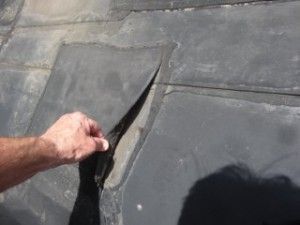Roof Problems – Telltale Signs that Your Roof Needs Attention
tlm_developer • July 7, 2016
Want to be able to identify the signs that the roof on your commercial building may be in need of inspection or repair? Here are five things to watch out for, with pictures to guide you. While these tips will help you identify a number of potential problems, it is always best to bring in a professional roofing consultant to help determine which repairs you and your team can handle, and those that require expert assistance.
- Alligatoring
. If you have an older asphalt roof, look for signs of ‘alligatoring.’ That’s when small cracks, resembling alligator skin, appear throughout the roof. These cracks are allowing water to seep into the structure below every time it rains or snows. If alligatoring is present, get a full inspection to determine of it’s time to replace your roof.

Alligatoring on Roof - Flashing & Counterflashing Pulling and Repairs.
Flashing and counterflashing can be problematic if not installed or maintained properly. These are also the areas where water intrusion is most likely to occur. Many building managers and maintenance teams will attempt to repair flashing issues on their own – by applying sealant or caulking affected areas. If handled incorrectly, these stopgap measures won’t last and water will continue to find its way through. Your roof inspector can advise you of the best way to handle these types of repairs.

Counterflashing pulling from the wall, as well as old, flaking sealant.

Repaired flashing, missing counterflashing and a roof that needs to be completely replaced. - Pipe and Vent Cap Issues.
Check around pipes, soil stacks and vent caps for erosion. Sealant should hold tight around these fixtures, with no breaks. If you see cracks in the sealant or an opening between the sealant and the roof fixture, these need to be repaired immediately as water is leaking through. You also want to look for any holes or breaks in vent caps, as these will allow water into the vent – which will then carry it throughout your building.

Large gap where the sealant has come away from the pipe.

Old vent caps riddled with pinholes. - Ponding Water or Discoloration at Membrane.
If you have ponding water on your roof or discoloration of the roof membrane, it means that water has gotten beneath the membrane. As the membrane is the barrier between your roof and the underlying structure, water here can result in wood rot and costly repairs if not addressed promptly.

Here is an example of ponding water. - Failing Seams at Roofing Membrane (EPDM).
Over time, membrane seams will erode and fail as the sealant is exposed to weather extremes. Check any and all seams to ensure the seals are still in place. Again, should you see any failures or erosion, address these quickly.

The photo here shows a failing seam.
Be sure your roof isn’t providing any opportunities for water to invade your structure. The architects, engineers and roof consultants at K2N Crest offer professional architectural and structural design and evaluation services to building owners and managers throughout Illinois and Hawaii. www.k2n.com

By tlm_developer
•
July 16, 2018
Falls from heights and on a working surface are among the leading causes of serious work-related injuries and deaths. In recent years, OSHA has updated its rule on Walking-Working Surfaces and Personal Fall Protection Systems (OSHA 1910.27(b)(1)(i) to better protect workers from these hazards—clarifying standards and adding training and inspection requirements. This rule is closely tied to another OSHA regulation requiring that a leading edge 6 feet or more above a lower level be protected by guardrail systems, safety net systems or personal fall arrest systems. To ensure worker safety and protect people and objects attached to the building from […]

By tlm_developer
•
June 26, 2018
Some structural engineering projects are just a little more interesting to work on than others. This was the case when K2N Crest was called in to evaluate flood damage impacting the foundational supports for a large water pipe crossing the ‘Iao River in Maui, Hawaii. The ‘Iao River flows through one of the state’s most beautiful parks. It is also the site where one of Hawaii’s bloodiest battles took place when Kamehameha I from the island of Hawai’i fought to unite the islands under his rule in 1790. There were so many slain from both armies during the battle at […]
By tlm_developer
•
May 24, 2017
“As our business continues to grow, we’ve increased staff to provide additional expertise in structural engineering and architectural design,” said Don Kimball, co-founder and President of K2N Crest. “Our most recent new hires allow K2N to continue to maintain high levels of service as we engage with a growing client base and participate in more expansive projects.” Kyle A. Cunningham attended the University of Illinois at Urbana-Champaign where he earned his Master of Architecture-Structures Option. He is an experienced project manager who previously provided asset and construction management support to a large, regional real estate development company. An engineer-in-training at K2N […]
